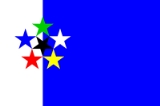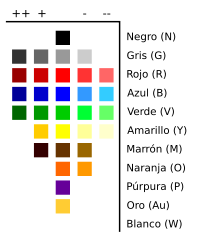
Flags of the World
Encyclopedia
- For a list of flags, see List of flags or Gallery of flags by design.
Flags of the World (or FOTW, or FotW) is an Internet
Internet
The Internet is a global system of interconnected computer networks that use the standard Internet protocol suite to serve billions of users worldwide...
-based vexillological association and resource. Its principal project is the Internet's largest website devoted to vexillology
Vexillology
Vexillology is the scholarly study of flags. The word is a synthesis of the Latin word vexillum, meaning 'flag', and the Greek suffix -logy, meaning 'study'. The vexillum was a particular type of flag used by Roman legions during the classical era; its name is a diminutive form of the word velum...
, containing comprehensive information about all kinds of flag
Flag
A flag is a piece of fabric with a distinctive design that is usually rectangular and used as a symbol, as a signaling device, or decoration. The term flag is also used to refer to the graphic design employed by a flag, or to its depiction in another medium.The first flags were used to assist...
s, and an associated mailing list
Electronic mailing list
An electronic mailing list is a special usage of email that allows for widespread distribution of information to many Internet users. It is similar to a traditional mailing list — a list of names and addresses — as might be kept by an organization for sending publications to...
. The mailing list began as a discussion group in about September 1993, while the website was founded by Giuseppe Bottasini in late 1994. FotW became the 56th member of the FIAV in 2001.
Flags of the World describes itself as "...an Internet group, the sole purpose of which is the advancement of the pursuit of vexillology, that is the creation and development of a body of knowledge about flags and flag usage of all types."
Both the website and the mailing list operate in the English language
English language
English is a West Germanic language that arose in the Anglo-Saxon kingdoms of England and spread into what was to become south-east Scotland under the influence of the Anglian medieval kingdom of Northumbria...
, though there are members from around the world and as such information from many languages is translated and included. The mailing list is monitored by the FOTW Listmaster, while work on the website is coordinated by the FOTW Editorial Director.
Website
An editorial staff of 21 unpaid volunteers manages and edits the FOTW website, which (as of mid-2009) contains more than 41,000 pages about flags and more than 78,000 images of flags, and also includes an extensive online dictionary of vexillologyVexillology
Vexillology is the scholarly study of flags. The word is a synthesis of the Latin word vexillum, meaning 'flag', and the Greek suffix -logy, meaning 'study'. The vexillum was a particular type of flag used by Roman legions during the classical era; its name is a diminutive form of the word velum...
.
The website is updated once a week with fresh material; some mirrors
Mirror (computing)
In computing, a mirror is an exact copy of a data set. On the Internet, a mirror site is an exact copy of another Internet site.Mirror sites are most commonly used to provide multiple sources of the same information, and are of particular value as a way of providing reliable access to large downloads...
update monthly. Due to the high amount of material there is an editing backlog, causing some areas of FOTW to contain outdated information. There are also some mirrors that have not been updated for varying periods of time and which are therefore considered "historical."
| Year | Pages | Images | Images/Page | Increase |
|---|---|---|---|---|
| 1996 | 674 | 710 | 1.05 | |
| 1997 | 1100 | 1400 | 1.27 | 81% |
| 1998 | 1900 | 3600 | 1.89 | 120% |
| 1999 | 2400 | 5000 | 2.08 | 35% |
| 2000 | 8200 | 14900 | 1.81 | 212% |
| 2001 | 11400 | 20700 | 1.81 | 39% |
| 2002 | 16600 | 29400 | 1.77 | 43% |
| 2003 | 19000 | 36000 | 1.89 | 20% |
| 2004 | 23000 | 43000 | 1.87 | 20% |
| 2005 | 29000 | 54000 | 1.86 | 26% |
| 2006 | 31000 | 58000 | 1.87 | 7% |
Mailing list
The source for material on the FOTW website are contributions to the FOTW mailing list, which currently has somewhat over 1000 members, of which some 100 are active contributors. The mailing list has notable minorities of PortuguesePortuguese language
Portuguese is a Romance language that arose in the medieval Kingdom of Galicia, nowadays Galicia and Northern Portugal. The southern part of the Kingdom of Galicia became independent as the County of Portugal in 1095...
, French
French language
French is a Romance language spoken as a first language in France, the Romandy region in Switzerland, Wallonia and Brussels in Belgium, Monaco, the regions of Quebec and Acadia in Canada, and by various communities elsewhere. Second-language speakers of French are distributed throughout many parts...
, Dutch
Dutch language
Dutch is a West Germanic language and the native language of the majority of the population of the Netherlands, Belgium, and Suriname, the three member states of the Dutch Language Union. Most speakers live in the European Union, where it is a first language for about 23 million and a second...
, and Russian
Russian language
Russian is a Slavic language used primarily in Russia, Belarus, Uzbekistan, Kazakhstan, Tajikistan and Kyrgyzstan. It is an unofficial but widely spoken language in Ukraine, Moldova, Latvia, Turkmenistan and Estonia and, to a lesser extent, the other countries that were once constituent republics...
speakers. A staff of three unpaid volunteers manages and moderates the list.
Graphical conventions

GIF
The Graphics Interchange Format is a bitmap image format that was introduced by CompuServe in 1987 and has since come into widespread usage on the World Wide Web due to its wide support and portability....
format, usually at a
height of 216 pixels. While the file format is limited to 256 colors,
the standard calls for a more restricted "FOTW palette" of 32
colors.
Flag
The organization's flag is an asymmetric white and blue vertical bicolor, with a circle of five upright stars surrounding an inverted black star centered somewhat above the midpoint of the dividing line. The design, by Mark Sensen, was selected over 10 challengers in a poll of FOTW mailing list members and was adopted March 8, 1996. Since then, March 8 has been regarded as FOTW's Flag dayFlag Day
A flag day is a flag-related holiday—either a day designated for flying a certain flag , or a day set aside to celebrate a historical event such as a nation's adoption of its flag....
. Sensen described its symbolism:
The flag is thus noteworthy as a rare representation of the Internet
Internet
The Internet is a global system of interconnected computer networks that use the standard Internet protocol suite to serve billions of users worldwide...
on a flag.
See also
- List of flags
- List of flags by country (small view)
- Gallery of country flags (larger-sized view)

